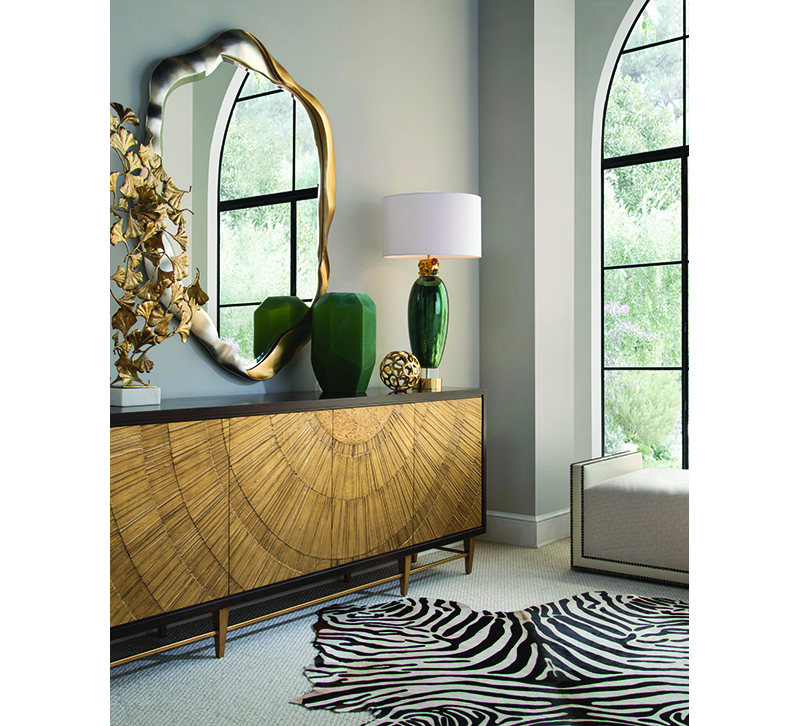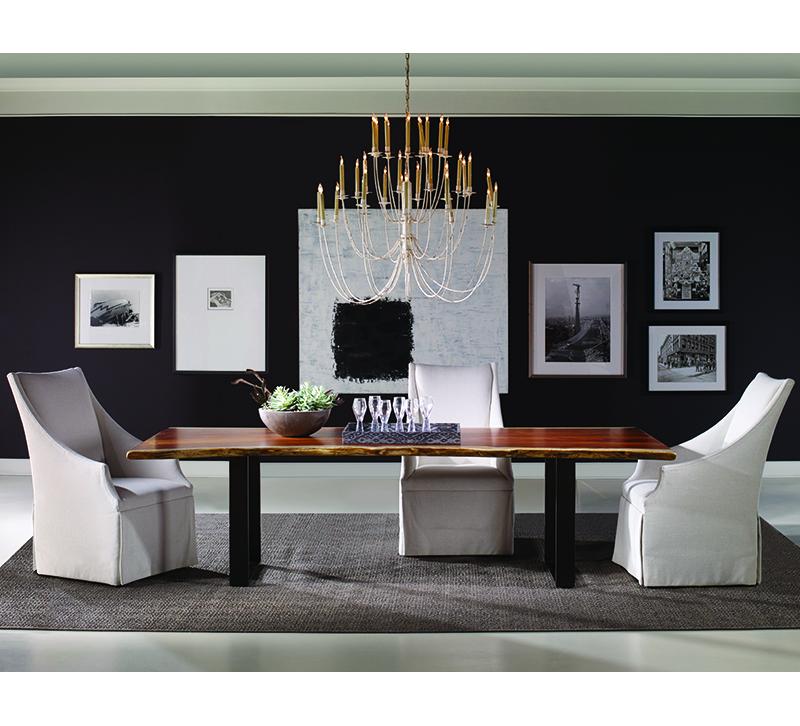In home furnishings, what defines luxury?
While our first thoughts might lean toward price tag, according to home furnishings makers, luxury is not simply about the dollar signs. “It’s very much about experience,” says Comer Wear, Vice President of Marketing for the Rock House Farm family of brands, which includes such brands as Century Furniture, Highland House, Jessica Charles and Hancock & Moore. “We want the end consumer to own the design,” she continues. “We are always working to come up with designs that allow the consumer to put as much of their personal imprint on them as possible.”
Allowing for the end consumer to put their stamp on home furnishings to give them that luxury experience requires lots of options — but the right ones — Wear continues, something the Rock House Farm family of brands takes into account when designing furniture to provide customization at varying levels of purchase.
At the high end of the spectrum, consumers will rely on the vision of their interior designers for the most part. For that upper echelon, Wear notes, customization is taken to a whole new level. “We want to give designers all of the crayons and creative materials to create the perfect room,” she says. A sofa, for example, could have different arms or myriad fabric choices; a dining table could have five different base options. And of course, there have to be varying size options to fit different rooms. “We can do all of that customization,” Wear continues, noting that for products to be approachable at retail, fewer choices work better for consumers making design decisions. However, there still needs to be choice for that luxury experience. It’s important to determine the right balance of options. At Rock House Farms, the brands, which follow a good, better, best hierarchy, account for the different touch points and the customers who will be drawn to their assortments when developing its customization options.
“The most important thing is for our customers to have a wow experience,” adds Jonathan Parks, Chief Marketing and Merchandising Officer at John-Richard. “That experience comes through design and quality.” To provide that stellar experience to its customers, the company offers a wide array of product, from artwork and lighting to upholstery and accent furniture.

Offerings in the John-Richard High Point showroom, for example, span styles and design aesthetics, ensuring there is something for everyone who visits. “People are expecting to see progression when they come in,” Parks says, adding that there is an eclectic nature to some of the company’s offerings. The showroom is merchandised, however, to showcase how products that seem completely different can be merchandised to work together. “It’s important for people to understand that each piece can stand alone because that’s how we envision it. As we layer the product in, these works also blend beautifully together. We spend so much time on the product and making sure it’s what consumers will want and need.”
A Quality Focus
In ensuring what consumers want and need, a primary focus for both John-Richard and the Rock House Farm family of brands revolves around quality. “Price point is not how we define John-Richard in the marketplace,” says Parks. “Most important are the processes that assure the quality is there.” For this company, the luxury comes at the hands of the artisans and the techniques used to build each piece. From paint and stenciling to sculptural moments on case goods to 100-year-old upholstery techniques, those who work at John-Richard put a collaborative effort into creating pieces built to last. Park adds that while the company has a blend of domestic and imported products, John-Richard owns its factories and can easily monitor the design and quality coming out of them. It’s an integral component of the brand experience.
At Rock House Farm, brand experience is also reliant on the quality of the pieces produced. “What we’re trying to build are products that are relevant but are also going to last,” Wear says.
Younger consumer demographics that now have money to spend put more emphasis on sustainability, and product quality becomes even more important, for example. “The younger consumer is coming around to the idea of purchasing things that will last as we become more aware of the environment,” she adds. “There is a nice tie together with sustainability and how products are made that will get consumers thinking about purchasing things they can live with and grow with.” Furniture, after all, says Wear, is not something we bring in for a season and then change out. “The items we build are the backbone of the home, things you are going to keep. That’s also luxury.”
Brand Stories, Customer Stories
None of this matters — the effort that goes into unique design, customization and quality — if retail customers, design clients and consumers aren’t aware of how the attention to detail and best practices define these manufacturers’ products as luxury items. That’s where education and storytelling comes in, areas where both John-Richard and the Rock House Farm brands put in the effort. “We do a lot of product training, especially for customers who need it,” says John-Richard’s Parks. In addition, John-Richard’s showroom is an opportunity for customers to see, touch and feel all the products. As important as each piece is how these furnishings will add to the consumer’s story. For that reason, everything from how each piece is made to display options is accessible. “It’s really important for us to be telling the story of our products — design history, material, technique and social or environmental initiatives,” Parks adds.
“The end consumer has a hard time seeing the value in upholstery,” says Wear, as an example of the importance of education. “You don’t think about feeling the springs until you have a problem.” It’s why Rock House Farm works so hard to share details of how the products are made, the inspiration behind the designs and where they are made, much of it in the U.S. As more consumers shop online, Wear notes that explaining the quality and personality of a luxury piece can get more complicated. It’s important to see and experience home furnishings, particularly upholstery, which makes markets and retail stores essential. “It’s difficult to convey the differences without seeing a piece in person and sitting in it,” she notes.
At the end of the day, luxury is ultimately about the experience when the furnishings have found their homes. “Think about the conversations you have around your dining room table, all of the emotion that’s wrapped around what goes on in your home,” says Wear. “These pieces are part of the memories.” That ability for the experience of a product to be transformed into a memory? That’s luxury. FLD







